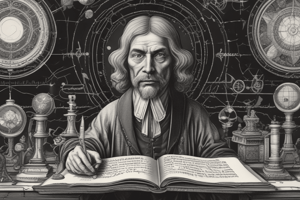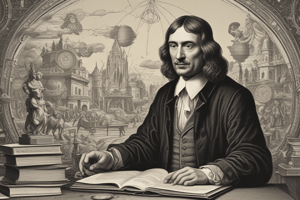Podcast
Questions and Answers
Which of the following statements best reflects Richard Dawkins' view on the relationship between religion and science?
Which of the following statements best reflects Richard Dawkins' view on the relationship between religion and science?
- Religion hinders scientific progress, making their coexistence difficult. (correct)
- Religion and science can coexist harmoniously, as they address different aspects of human existence.
- Science is a subset of religious thought, providing empirical evidence for divine creation.
- Religion provides a necessary ethical framework for guiding scientific inquiry.
John Lennox posits that the central conflict is not between science and Christianity, but rather between:
John Lennox posits that the central conflict is not between science and Christianity, but rather between:
- Empirical observation and philosophical speculation.
- Deductive and inductive reasoning.
- Different interpretations of religious texts.
- Naturalism and theism. (correct)
What is the primary contribution of Francis Bacon to the scientific method?
What is the primary contribution of Francis Bacon to the scientific method?
- The emphasis on deductive reasoning from established principles.
- The introduction of falsifiability as a criterion for scientific theories.
- The concept of scientific revolutions that periodically change dominant paradigms.
- The development of empirical observation and inductive reasoning. (correct)
According to Karl Popper, what differentiates a scientific theory from a non-scientific one?
According to Karl Popper, what differentiates a scientific theory from a non-scientific one?
Thomas Kuhn's concept of scientific revolutions suggests that scientific progress is:
Thomas Kuhn's concept of scientific revolutions suggests that scientific progress is:
Which of the following best describes Aristotle's teleological view of nature?
Which of the following best describes Aristotle's teleological view of nature?
Ptolemy's geocentric model of the universe was widely accepted for centuries. What was the central claim of this model?
Ptolemy's geocentric model of the universe was widely accepted for centuries. What was the central claim of this model?
Democritus's atomic theory proposed that:
Democritus's atomic theory proposed that:
Copernicus challenged the prevailing cosmological model by proposing:
Copernicus challenged the prevailing cosmological model by proposing:
Tycho Brahe's model of the solar system can be described as:
Tycho Brahe's model of the solar system can be described as:
Galileo Galilei's support for heliocentrism led to conflict with religious authorities primarily because:
Galileo Galilei's support for heliocentrism led to conflict with religious authorities primarily because:
Johannes Kepler's laws of planetary motion demonstrated that planetary orbits are:
Johannes Kepler's laws of planetary motion demonstrated that planetary orbits are:
Newton's first law of motion, the law of inertia, states that:
Newton's first law of motion, the law of inertia, states that:
John Dalton's atomic theory posited that:
John Dalton's atomic theory posited that:
Dmitri Mendeleev organized the elements in the periodic table based on:
Dmitri Mendeleev organized the elements in the periodic table based on:
J.J. Thomson's cathode ray tube experiment led to the discovery of:
J.J. Thomson's cathode ray tube experiment led to the discovery of:
Ernest Rutherford's gold foil experiment demonstrated that:
Ernest Rutherford's gold foil experiment demonstrated that:
Niels Bohr's model of the atom proposed that:
Niels Bohr's model of the atom proposed that:
Albert Einstein's theory of relativity introduced the concept that:
Albert Einstein's theory of relativity introduced the concept that:
Lise Meitner's work with Otto Hahn led to the discovery of:
Lise Meitner's work with Otto Hahn led to the discovery of:
Gerhard Domagk is best known for his discovery of:
Gerhard Domagk is best known for his discovery of:
Fritz Haber's Haber-Bosch process enabled the large-scale production of:
Fritz Haber's Haber-Bosch process enabled the large-scale production of:
The 'God of the gaps' concept is often criticized because it:
The 'God of the gaps' concept is often criticized because it:
The 'Two Books of Revelation' concept suggests that:
The 'Two Books of Revelation' concept suggests that:
Which of the following is NOT a characteristic commonly associated with the scientific method?
Which of the following is NOT a characteristic commonly associated with the scientific method?
Which of the following questions falls outside the limits of scientific inquiry?
Which of the following questions falls outside the limits of scientific inquiry?
Methodological naturalism, as it applies to science, suggests that:
Methodological naturalism, as it applies to science, suggests that:
Retrograde motion, the apparent backward movement of planets, is caused by:
Retrograde motion, the apparent backward movement of planets, is caused by:
In the context of the geocentric model, what is an epicycle?
In the context of the geocentric model, what is an epicycle?
What is the key difference between the heliocentric and geocentric models of the universe?
What is the key difference between the heliocentric and geocentric models of the universe?
Flashcards
Richard Dawkins' View
Richard Dawkins' View
The belief that faith is for the blind, while science is based on evidence, and that religion hinders scientific progress.
John Lennox's Argument
John Lennox's Argument
The argument that Christianity was a driving force for scientific advancement, with the true conflict being between naturalism and theism.
Francis Bacon
Francis Bacon
Developed the scientific method, emphasizing empirical observation and inductive reasoning to gain knowledge through experiments.
Karl Popper's Falsifiability
Karl Popper's Falsifiability
Signup and view all the flashcards
Thomas Kuhn's Scientific Revolutions
Thomas Kuhn's Scientific Revolutions
Signup and view all the flashcards
Aristotle's Reasoning
Aristotle's Reasoning
Signup and view all the flashcards
Ptolemy's Model
Ptolemy's Model
Signup and view all the flashcards
Democritus' Atomic Theory
Democritus' Atomic Theory
Signup and view all the flashcards
Copernicus' Model
Copernicus' Model
Signup and view all the flashcards
Tycho Brahe's Model
Tycho Brahe's Model
Signup and view all the flashcards
Galileo Galilei
Galileo Galilei
Signup and view all the flashcards
Johannes Kepler's Laws
Johannes Kepler's Laws
Signup and view all the flashcards
Isaac Newton
Isaac Newton
Signup and view all the flashcards
Law of Inertia
Law of Inertia
Signup and view all the flashcards
John Dalton's Atomic Theory
John Dalton's Atomic Theory
Signup and view all the flashcards
Dmitri Mendeleev
Dmitri Mendeleev
Signup and view all the flashcards
J.J. Thompson
J.J. Thompson
Signup and view all the flashcards
Ernest Rutherford
Ernest Rutherford
Signup and view all the flashcards
Niels Bohr Model
Niels Bohr Model
Signup and view all the flashcards
Albert Einstein
Albert Einstein
Signup and view all the flashcards
Lise Meitner
Lise Meitner
Signup and view all the flashcards
Gerhard Domagk
Gerhard Domagk
Signup and view all the flashcards
Fritz Haber
Fritz Haber
Signup and view all the flashcards
Powers of 10
Powers of 10
Signup and view all the flashcards
Antibiotics
Antibiotics
Signup and view all the flashcards
God of the Gaps
God of the Gaps
Signup and view all the flashcards
Two Books of Revelation
Two Books of Revelation
Signup and view all the flashcards
Characteristics of Science
Characteristics of Science
Signup and view all the flashcards
Empirical, Objectivity, Rationality
Empirical, Objectivity, Rationality
Signup and view all the flashcards
Manhattan Project
Manhattan Project
Signup and view all the flashcards
Study Notes
- Faith relies on belief without proof, whereas science depends on evidence.
- Religion can impede scientific advancement, according to Richard Dawkins, making coexistence difficult.
- John Lennox contends that Christianity was a driving force behind scientific progress.
- The central conflict is between naturalism and theism
- Naturalism posits that everything can be explained through natural causes.
- Theism posits the belief relating to God
Scientific Method
- Formulated by Francis Bacon
- Involves empirical observation and inductive reasoning
- Used to gain knowledge through experiments.
- Karl Popper introduced falsifiability
- Hypotheses are tested, and failed ones are rejected, to advance scientific knowledge.
Scientific Advancement
- According to Thomas Kuhn, science advances through revolutions, where dominant theories replace older ones rather than in a linear and constant way.
- Aristotle promoted deductive reasoning
- General principles lead to logical conclusions.
- Teleology states that everything in nature possesses a purpose or final cause.
- Aristotle proposed that all matter consists of earth, water, air, fire, and aether.
- Ptolemy's geocentric model, which places Earth at the center of the universe, was accepted for 1000 years.
- The moon, sun, and planets were thought to orbit Earth.
- Democritus proposed that the world consists of atoms
- His atomic theory lacked experimental proof but influenced the modern understanding of atoms.
- Copernicus introduced the heliocentric model
- Incorrectly assumed circular orbits but correctly placed the sun at the center of the universe.
- Tycho Brahe created a hybrid model: Earth is stationary, but the Sun orbits it.
Discoveries
- Galileo Galilei improved the telescope
- Arrested for heresy for advocating heliocentrism.
- Johannes Kepler determined that planets orbit the sun in ellipses, not circles.
- His laws of planetary motion supported the heliocentric model.
Laws of Motion
- Isaac Newton supported the three laws of motion and universal gravitation.
- Law of Inertia
- Law of Acceleration
- Action-Reaction Law
- John Dalton proposed that all matter is composed of indivisible atoms.
- Dmitri Mendeleev created the periodic table
- Organizing elements by atomic mass
- Predicting undiscovered elements.
- J.J. Thomson discovered the electron in 1897 using a cathode ray tube
- This discovery led to the plum pudding model of the atom.
- Ernest Rutherford discovered the nucleus through the gold foil experiment
- Proving atoms have a small, dense, positively charged center.
- Niels Bohr proposed that electrons orbit the nucleus in fixed energy levels.
- Albert Einstein proposed the theory of relativity
- Including E=mc², that describes the relationship between energy and mass.
- Lise Meitner discovered nuclear fission
- Helped explain how splitting atomic nuclei releases energy
- Laying the groundwork for nuclear power and atomic bombs.
- Gerhard Domagk discovered Prontosil, the first commercially available antibiotic
- Led to sulfa drugs that revolutionized bacterial infection treatment.
- Fritz Haber developed the Haber-Bosch process for large-scale ammonia production
Key Terms and Concepts
- Powers of 10 express large or small numbers in scientific notation using multiplication of 10.
- Antibiotics kill or inhibit bacterial growth by targeting bacterial structures or functions.
- Penicillin was discovered by Alexander Fleming.
- God of the Gaps attributes unexplained phenomena to divine intervention, which critics argue hinders scientific exploration.
- Two Books of Revelation suggests God reveals truth through nature (science) and scripture, with conflicts arising from misinterpretation.
- Science is empirical, objective, and rational
- Relying on observation, experimentation, and logical reasoning.
- Key steps in the scientific method involve observation, hypothesis, experimentation, and conclusion.
- Science is limited to investigating the natural world and cannot address moral, aesthetic, or supernatural questions.
- Traditional science seeks universal truths through systematic observation and experimentation, assuming an orderly universe.
- Empirical evidence, objectivity, and rationality are key to science
- Ensuring valid conclusions through unbiased observation and logical reasoning.
Theories
- A scientific theory must be testable and falsifiable, according to Popper’s Falsification
- Science evolves through shifts in dominant theories (paradigms), with revolutions occurring when new evidence challenges existing beliefs, according to Kuhn’s Paradigms and Scientific Revolutions.
- Scientific theories are shaped by fundamental principles and empirical data that evolve with new discoveries.
- Reductionism simplifies complex systems by studying simpler parts, though critics argue it oversimplifies.
- Determinism suggests all events follow causal laws
- Materialism states everything is physical
- Scientism claims science is the only path to knowledge.
Ideologies
- Christian theism believes in a divine creator
- Naturalism rejects the supernatural
- Postmodernism questions absolute truth.
- Methodological naturalism assumes natural causes for phenomena in science.
- Retrograde motion is the apparent backward motion of planets due to Earth's movement.
- An epicycle is a small circular orbit within a planet’s main orbit, used in the geocentric model to explain planetary motion.
- Heliocentric places the Sun at the center of the universe, while geocentric places Earth at the center.
- Aristotle's science included five elements, deduction, and teleology
- He focused on purpose and logical deduction, proposing earth, water, air, fire, and aether as fundamental elements.
Laws
- Newton’s Laws of Motion:
- Objects remain in motion unless acted upon.
- Force equals mass times acceleration.
- Every action has an equal and opposite reaction.
- Newton’s Law of Universal Gravity: Every mass attracts every other mass, depending on mass and distance.
- Deism believes in a non-intervening creator, viewing the universe as a predictable machine or clockwork universe.
- Average speed is total distance divided by time, while instantaneous speed is speed at a specific moment.
- A derivative measures how a function changes, with the power rule stating d/dx [xⁿ] = n*xⁿ⁻¹.
- Ancient civilizations developed unique numerical notations, with Indian numerals evolving into the modern decimal system.
- Algebra solves equations using symbols, and the imaginary unit (i) represents the square root of -1.
- Protons and neutrons are in the nucleus, while electrons orbit
- Protons are positive, neutrons are neutral, and electrons are negative.
- Rutherford’s experiment showed atoms have a dense nucleus, with most of an atom being empty space.
- The nucleus contains protons and neutrons, isotopes have different neutron counts, and ions are charged atoms, represented in notation like ²³Na⁺.
- Elements are pure substances organized by atomic number and properties in the periodic table.
- Nuclear fission, or splitting of atomic nuclei, releases energy, powering nuclear reactors and bombs.
- The Manhattan Project was a secret WWII project that developed nuclear weapons, leading to bombings of Hiroshima and Nagasaki.
Bonding
- Ionic bonding transfers electrons
- Covalent bonding shares them
- Polar bonds have unequal sharing, while non-polar bonds share equally.
- Intermolecular forces act between molecules, and intramolecular forces hold atoms together within molecules.
- Essential molecules for life include H₂O, O₂, N₂, CO₂, NH₃, O₃, and CH₄.
- The Haber-Bosch Process synthesizes ammonia for fertilizer production on a large scale.
- Nitrogen fixation converts atmospheric nitrogen into usable forms through bacteria and industrial methods.
- The nitrogen cycle moves nitrogen through ecosystems via fixation, assimilation, nitrification, and denitrification.
- Eutrophication, algae blooms, and dead zones are caused by excess nutrients that lead to algal overgrowth, oxygen depletion, and aquatic life deaths.
Studying That Suits You
Use AI to generate personalized quizzes and flashcards to suit your learning preferences.




